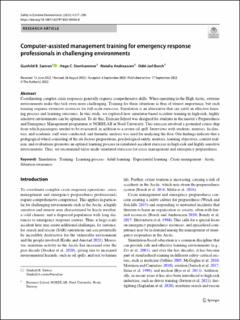| dc.contributor.author | Sætren, Gunhild Birgitte | |
| dc.contributor.author | Stenhammer, Hege Christin | |
| dc.contributor.author | Andreassen, Natalia | |
| dc.contributor.author | Borch, Odd Jarl | |
| dc.date.accessioned | 2022-11-28T11:22:43Z | |
| dc.date.available | 2022-11-28T11:22:43Z | |
| dc.date.created | 2022-09-18T08:23:38Z | |
| dc.date.issued | 2022 | |
| dc.identifier.citation | Sætren, G. B., Stenhammer, H. C., Andreassen, N. & Borch, O. J. (2022). Computer‑assisted management training for emergency response professionals in challenging environments. Safety in Extreme Environments, 4, 277–290. doi: | en_US |
| dc.identifier.issn | 2524-8189 | |
| dc.identifier.uri | https://hdl.handle.net/11250/3034437 | |
| dc.description.abstract | Coordinating complex crisis responses generally requires comprehensive skills. When operating in the High Arctic, extreme environments make this task even more challenging. Training for these situations is thus of utmost importance, but such training requires extensive resources for full-scale exercises. Simulation is an alternative that can yield an effective learning process and learning outcomes. In this study, we explored how simulator-based accident training in high-risk, highly sensitive environments can be optimised. To do this, Exercise Isfjord was designed for students in the master’s Preparedness and Emergency Management programme at NORDLAB at Nord University. This exercise involved a grounded cruise ship from which passengers needed to be evacuated, in addition to a severe oil spill. Interviews with students, mentors, facilitators, and academic staff were conducted, and thematic analysis was used for analysing the data. Our findings indicate that a pedagogical wheel consisting of the six factors preparations, psychological safety, mentors, learning objectives, context realism, and evaluations promotes an optimal learning process in simulated-accident exercises in high-risk and highly sensitive environments. Thus, we recommend tailor-made simulated exercises for crisis management and emergency preparedness. | en_US |
| dc.description.abstract | Computer‑assisted management training for emergency response professionals in challenging environments | en_US |
| dc.language.iso | eng | en_US |
| dc.rights | Navngivelse 4.0 Internasjonal | * |
| dc.rights.uri | http://creativecommons.org/licenses/by/4.0/deed.no | * |
| dc.subject | Sikkerhetspsykologi | en_US |
| dc.subject | Safety psychology | en_US |
| dc.subject | Pedagogisk psykologi | en_US |
| dc.subject | Psychology of education | en_US |
| dc.title | Computer‑assisted management training for emergency response professionals in challenging environments | en_US |
| dc.title.alternative | Computer‑assisted management training for emergency response professionals in challenging environments | en_US |
| dc.type | Peer reviewed | en_US |
| dc.type | Journal article | en_US |
| dc.description.version | publishedVersion | en_US |
| dc.rights.holder | © 2022 The Author(s) | en_US |
| dc.subject.nsi | VDP::Samfunnsvitenskap: 200::Psykologi: 260::Sosial- og arbeidspsykologi: 263 | en_US |
| dc.subject.nsi | VDP::Samfunnsvitenskap: 200::Psykologi: 260::Organisasjonspsykologi: 268 | en_US |
| dc.subject.nsi | VDP::Samfunnsvitenskap: 200::Pedagogiske fag: 280::Andre pedagogiske fag: 289 | en_US |
| dc.source.pagenumber | 277–290 | en_US |
| dc.source.volume | 4 | en_US |
| dc.source.journal | Safety in Extreme Environments | en_US |
| dc.identifier.doi | 10.1007/s42797-022-00066-0 | |
| dc.identifier.cristin | 2052723 | |

